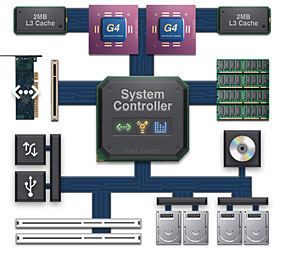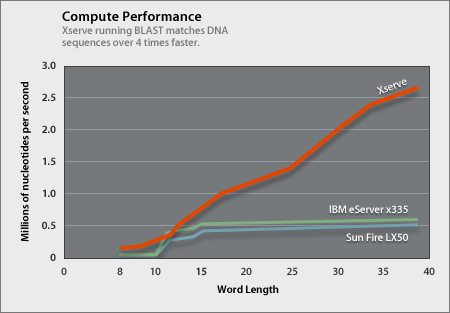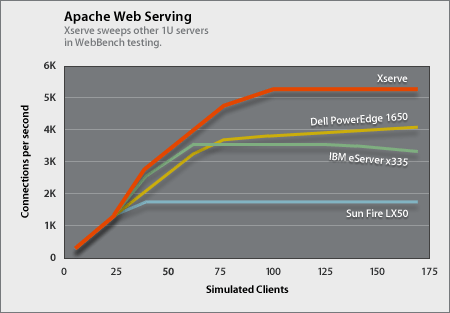
|

|
Xserve server-optimized system architecture
includes ultra-efficient PowerPC G4 processors, a superfast memory architecture
and a high-bandwidth I/O system. And these powerful hardware features are
enhanced by the industrial-strength Mac OS X Server, which is optimized for
superior performance on Xserve systems.
Eat our dust Xserve leaves the 1U crowd behind when you need heavy duty lifting for computational biology. Stack us up against the others in our class and you’ll need four of them for every one of us when it comes to matching DNA sequences. At the long word length of 40, Xserve is nearly five times faster than both the IBM xSeries 335 and the Sun LX50.* This dramatic performance advantage enables you to compute more specific and more accurate comparisons at longer word length searches — operations that are prohibitively slow on other 1U server systems. In fact, only at a word length of 11, for which NCBI BLAST has been extensively optimized, do the IBM and Sun systems perform comparably to Xserve. 
WebBench press champion Xserve running Apache on Mac OS X Server outperforms all three other 1U servers running Apache on Linux operating systems. Xserve is 29% faster than the PowerEdge 1650, 47% faster than the IBM eServer xSeries 335 and nearly twice as fast as the Sun LX50.** These results demonstrate the benefit of the high-throughput Xserve architecture, optimized for demanding server tasks. In addition, Xserve running QuickTime Streaming Server can deliver more than 3,000 independent low-bit-rate streams simultaneously — without a per-stream license fee. Almost 800 gigaflops of processing power The 1.33GHz G4 processor is designed for full-throttle performance. It includes a powerful floating-point unit, the Velocity Engine vector processing unit and parallel processing capabilities. In fact, one dual processor system can execute up to 19 billion floating-point operations per second, or 19 gigaflops. So an industry standard rack stacked with dual-processor Xserve systems can deliver 798 gigaflops of processing power.  1.33GHz PowerPC G4 processor. The PowerPC G4 features a short
seven-stage pipeline, full 128-bit memory paths between L1 and L2 cache and
a floating-point unit that’s capable of executing double-precision mathematical
calculations in a single processor cycle. The PowerPC G4 also supports prefetching
(which improves performance by retrieving and caching data before it’s actually
demanded by the processor) with up to four simultaneous 32-bit data streams.
1.33GHz PowerPC G4 processor. The PowerPC G4 features a short
seven-stage pipeline, full 128-bit memory paths between L1 and L2 cache and
a floating-point unit that’s capable of executing double-precision mathematical
calculations in a single processor cycle. The PowerPC G4 also supports prefetching
(which improves performance by retrieving and caching data before it’s actually
demanded by the processor) with up to four simultaneous 32-bit data streams.Velocity Engine. The PowerPC G4 processor boosts efficiency further with the Velocity Engine, a fearsomely fast, 128-bit vector parallel processing unit. In applications written to take advantage of vector processing, the Velocity Engine accelerates processing by executing an operation on multiple pieces of data at the same time. It processes data in 128-bit chunks, instead of the 32-bit or 64-bit chunks that are the norm in traditional processors. Velocity Engine support is built into Mac OS X Server to turbocharge high-bandwidth data processing and math-intensive tasks. Dual RISC processors. Xserve is the industry’s first server to offer dual RISC processors in a 1U enclosure. Dual 1.33GHz PowerPC G4 processing delivers that high-density computational punch for processor-intensive tasks. Mac OS X Server harnesses this power by dynamically managing multiple tasks across both processors, allowing the dual-processor server to accomplish up to twice as much as a single-processor system in the same time. And since Mac OS X Server is multithreaded, server applications that use system services like file sharing and networking get a dramatic performance boost when they run on the dual-processor Xserve. Performance tests by Apple, January, 2003. *Xserve was tested using A/G BLAST, while the IBM eServer xSeries 335 and Sun LX50 Server ran NCBI-BLAST under Linux. **Web server performance was measured using market-leading Apache software on all platforms. The Dell PowerEdge 1650 and the IBM eServer xSeries 335 both ran Red Hat Linux; the Sun LX50 Server was tested under Sun Linux. |
Advanced memory architecture Xserve maximizes the efficiency of its computing power with an advanced memory architecture: An enhanced system bus, dedicated ultrafast L3 cache memory and Double Data Rate (DDR) main memory. Faster system bus. All configurations of the new Xserve are equipped with a 167MHz system bus for high-performance I/O.  L3 cache. With 2MB of high-speed DDR SRAM providing fast access
to data and application code (up to five times faster than from main memory),
the Xserve system’s L3 cache features a dedicated 64-bit data path to the
processor, providing 3.5GB/s of throughput without interference from other
data transfers. In dual processor systems, each processor has its own L3
cache (which also allows the two processors to share data without pausing
to update main memory) and dedicated high-throughput bus.
L3 cache. With 2MB of high-speed DDR SRAM providing fast access
to data and application code (up to five times faster than from main memory),
the Xserve system’s L3 cache features a dedicated 64-bit data path to the
processor, providing 3.5GB/s of throughput without interference from other
data transfers. In dual processor systems, each processor has its own L3
cache (which also allows the two processors to share data without pausing
to update main memory) and dedicated high-throughput bus. Double Data Rate (DDR) memory. Xserve has four DIMM slots that
take industry-standard PC2700 DDR SDRAM memory. This high-speed memory handles
two memory operations per clock cycle for a 333MHz data rate — a blistering
2.7GB/s throughput that’s more than twice that of the Single Data Rate (SDR)
PC133 memory used in many other servers in this range. Memory capacity is
scalable up to 2GB, letting you scale up your server memory to run RAM-hungry
applications simultaneously and to accommodate sharp spikes in demand.
Double Data Rate (DDR) memory. Xserve has four DIMM slots that
take industry-standard PC2700 DDR SDRAM memory. This high-speed memory handles
two memory operations per clock cycle for a 333MHz data rate — a blistering
2.7GB/s throughput that’s more than twice that of the Single Data Rate (SDR)
PC133 memory used in many other servers in this range. Memory capacity is
scalable up to 2GB, letting you scale up your server memory to run RAM-hungry
applications simultaneously and to accommodate sharp spikes in demand.Direct memory access. Xserve I/O subsystems have direct access to the high-speed DDR memory — allowing PCI cards and hard drives to work faster and freeing the processor from involvement with the data transfer. High-performance PCI slots. Xserve features two full-length 64-bit, 66MHz PCI slots with phenomenal throughput up to 533Mb/s — ample bandwidth for demanding I/O applications and connectivity to high-performance networking, storage and backup devices, using the Apple Fibre Channel PCI Card, for example.  Dual independent Gigabit Ethernet ports. Two Gigabit Ethernet
ports — one on the main logic board and one on a PCI card installed in the
half-length PCI/AGP slot — provide tremendous networking bandwidth. Each
is hosted on a separate PCI bus to ensure maximum throughput for each port.
Dual independent Gigabit Ethernet ports. Two Gigabit Ethernet
ports — one on the main logic board and one on a PCI card installed in the
half-length PCI/AGP slot — provide tremendous networking bandwidth. Each
is hosted on a separate PCI bus to ensure maximum throughput for each port.VGA graphics port. The preinstalled graphics card features a VGA port for connecting to industry-standard VGA displays and KVM (keyboard, video and mouse) switches. It supports headless booting by defaulting to a known safe resolution (1024 by 768 pixels at 60Hz) and lets you hot-plug a display to the server. ATI Radeon 8500 graphics processing unit (GPU). If you’re a creative professional who plans to use Xserve as a rack mount workstation, you can order a system with an ATI Radeon 8500 graphics processing unit (with 64MB of DDR video memory, dual display support and DVI, VGA and S-video connectors) preinstalled in the AGP 4X slot.  Three FireWire ports. Two FireWire 800 ports on the back panel
and one FireWire 400 port on the front panel let you connect to high-bandwidth
FireWire devices such as storage units and audio and video input devices.
IP over FireWire lets you connect servers together while reserving Gigabit
Ethernet bandwidth for network clients.
Three FireWire ports. Two FireWire 800 ports on the back panel
and one FireWire 400 port on the front panel let you connect to high-bandwidth
FireWire devices such as storage units and audio and video input devices.
IP over FireWire lets you connect servers together while reserving Gigabit
Ethernet bandwidth for network clients.Two USB ports. You can easily connect keyboards, mice and other peripherals. DB-9 serial port. An industry-standard 9-pin serial port provides system access through a serial console session. Optical drive. Use the slot-loading CD-ROM for software installation or choose a Combo drive to read DVD or write files to CD-ROM. |
| . | . | . |
| - |
Xserver
|
Februar |
|
Xserver RAID
|
2003
|